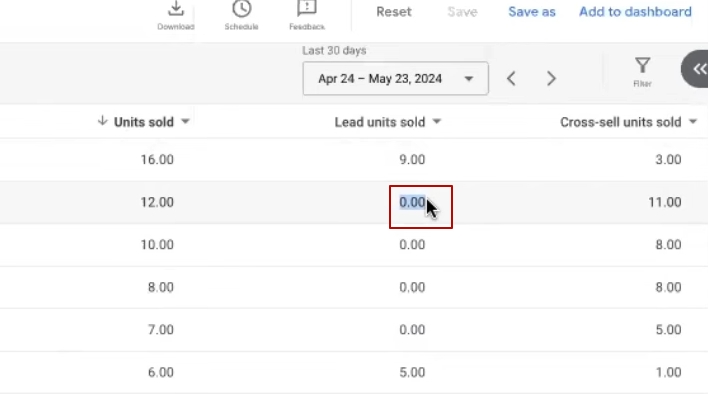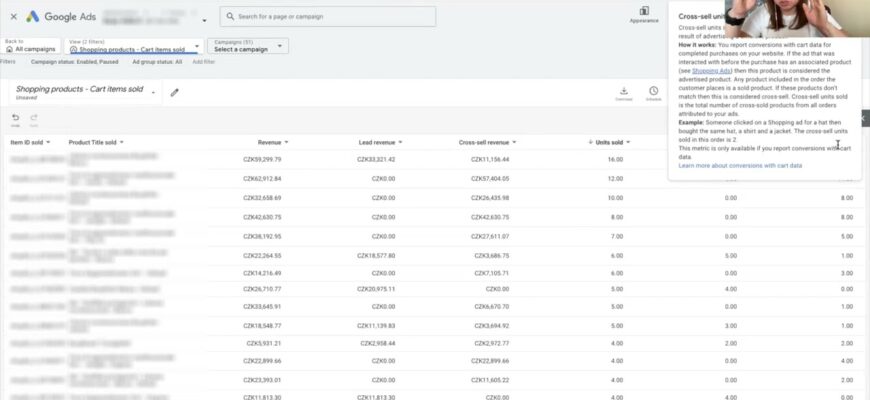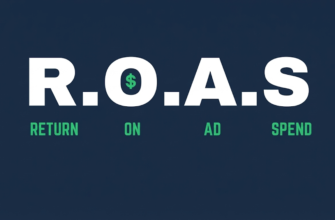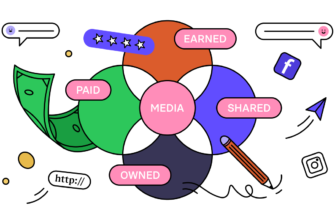- Types of goods according to the American method. Errors in selecting bestsellers
- The situation when bestsellers do not sell. Google Ads analysis report for this problem situation
- Deciphering the indicators generated in the report
- An example of a product that does not convert well into direct sales; alke works in cross-selling
- How performance works. The evolution of Google advertising tools
- Why you don’t need to duplicate feeds in Performance Max
- Positive picture of cross-sale sales
- Recommendation for the transfer of expanded tracking
- Conclusions
Hello everyone! My name is Yana Lyashenko and I am a Google logistician. I am engaged in delivering business to the target audience with the necessary parameters. My mission is to scale online business sales using Google advertising tools. Today we will talk about the mistake in structuring your Max’s Performance, when you try to build your structure according to a unique quadrant. The essence of this quadrant is that you analyze your product positions based on whether they sell, don’t sell, poorly, little, etc.
Types of goods according to the American method. Errors in selecting bestsellers
For example, for the Americans, this SWOT analysis includes, for example, hero-products – these are very cool sellers. In some Ukrainian bloggers you can find such information as bestsellers, top positions, something like that. And we, the Americans, have goods, for example, zombies, there, dead (dead people). Still there once. They do this SWOT analysis differently. For example, for me this still comes from simple ordinary economic analysis. These are cash cows, dead dogs, stars and zeros. This is how it breaks down for me.
But I very often come across such a breakdown in consultations, which concerns precisely the breakdown: bestsellers, they have, yes, top products that should be sold, and all other products. There is one big mistake that is often made in this breakdown. Some niches select these bestsellers incorrectly. Sometimes they are included in a separate advertising campaign. They stop working completely. Not because the advertising budget was low or anything related to it, but because the products were selected incorrectly. So I will show in this video where to find this information, is this really a bestseller or is it not a bestseller at all?
How many calls and sales will I get by ordering contextual advertising from you?
I need to calculate the conversion of my website Describe
the task
in the application
Calculate potential ad revenue Google
contextual advertising calculator
Because, in general, a product item in order to get into bestsellers, well, that is, into eye products, cash cows as I call them, I will use my terminology. For me, this is a cash cow, this is a product that can generate sales month after month and is very easy to scale due to the fact that you increase clicks on it. If you have the opposite situation, performances completely break down, these products stop working, this happens very often, although these are best-selling products, that’s right, cash cows, then you have selected these cash cows incorrectly. Usually the problem happens on small accounts where there are less than 50-60 sales per week for this cash cow. Then many projects encounter this and when you try to group them somehow this is where the problem arises.
That is, globally, the derivative, the effective operation of the performance, is not really influenced, in principle, by your signal, which you bother with, somehow arrange, it takes part in the work there, in the first A/B tests. Then the performance can say: this doesn’t suit me and go in a different direction. You can analyze this based on your statistics. Is the object available? No. Here is your feed that you upload, this is the basis for understanding the machine learning AI that sits here about who to target. Therefore, a lot depends on the structure of your products. I’ll show you an advertising account with a very interesting situation. If you analyze something incorrectly, you can classify something entirely as dead dogs and suspend it, while something else can be incorrectly identified as goods that can be sold.
The situation when bestsellers do not sell. Google Ads analysis report for this problem situation
Moreover, there are situations when, for example, this product item should, in theory, be a bestseller, and in this project we were faced with the fact that the client says this product item should be in high demand now. For this holiday or something like that. We try to run it separately and it doesn’t work at all. Well, that is, we spend it and do nothing. We rule him out. But what are we doing? We cunningly cross it with other goods and it begins to sell.
I will show this using the example of one of the reports, which is an example here. This report is very easy for you, it’s a direct standard report, you don’t need to generate anything there, generate it yourself, Google itself will offer it to you. It is as simple as possible without complication. I won’t even add complications here. It is based on items sold. In order for it to be formed for you and it opens up, in principle, the opportunity to form it, you need to configure the correct transmission of the purchase tag itself. That is, purchase Google Eds and add to cart.
Yes, just look, in no case do we transfer adding to cart to the status of the main goals there, because now you’ll create goals and then something will start floating around you and you’ll say that the bloggers on YouTube said something there. Here. But the correct transmission is if you look there, you still need to transfer item-si. Well, that is, so that he understands the product ID, quantity, price. He can convey it all beautifully.
Where did we stop? Look, we have such a cool report. This is one of the parts of product analysis. Product analysis can be quite different. In most cases, the client wants to directly see an increase in the number of conversions in an advertising campaign, to see a certain ROAS. Of course, there the product analysis is done a little differently. Here I am showing situations when, well, there is no other way to make some kind of intersection of these products or structures.

In general, if we look… This is our foreign project. This is our Italy, it seems. It is important to understand here that most of these businesses in Europe or America do not have a very large product range like ours. For example, they go to auto parts, and there are 700,000 product items. Everything needs to be sold. There are also such patterns, especially at high speeds, in large product positions. This can also be tracked, but all these volumes of goods are small. Therefore, it is a little more convenient for them to analyze. So don’t think that if you have 100,000 products there, that’s all you can analyze. 98 percent of your product range there simply doesn’t work. Therefore, focus on everything that has at least 50-60 clicks on products, for example, in at least a month, or it would be ideal in a week. You can ignore everything else during this analysis.
Deciphering the indicators generated in the report
What do we see? Here we see the following picture. I’ll decipher what these columns mean for us. There are Units sold, Lead units sold and Cross-sell units sold. What do they mean? I will use the examples that Google gives, because, most likely, it will be even much simpler.
Units sold is the number of generally sold goods… Let’s say this, we can say this is the number of sold goods/orders associated with a click on this product item. It’s clear? Total quantity.

This Lead units sold is the direct number of orders for this product item. Clicks, clicks, clicks. And then order this product item.
This Cross-sell means that this cross-sell sale was due to clicks on this product item. Now I’ll explain. Google gives some very cool ones here, I think this is a very cool example. That’s if we sell there. What do we have here? Hats, shirts and jackets. If the click was on the header, let’s say the first ID is the header. If you bought a hat, a shirt and a jacket, then three things will be displayed in this column. That’s right, this order contained three. Because it is associated with a click on this ad, on this product.
Lead units sold is when we have the same hat, jacket and shirt, but bought this hat directly. Therefore, here is one thing, for example, conditionally. And Cross-sell units, we’re coming back – hats, jackets, shirts. There was a click on the header. Right? We bought directly a hat, a shirt and a jacket, but we are already displaying two pieces. Without this header on which there was a click. Well, if anything happens, you’ll come back and suddenly I’ve confused you, there’s a whole interpretation here. Here I am, maybe someone out there will want to translate it for themselves. The same with Revenue, Lead revenue and Cross-sell revenue. But what does this give us?
How many calls and sales will I get by ordering contextual advertising from you?
I need to calculate the conversion of my website Describe
the task
in the application
Calculate potential ad revenue Google
contextual advertising calculator

An example of a product that does not convert well into direct sales; alke works in cross-selling
Look here. There are situations when you, for example, have this product item. Let’s take the second ID. This direct sale converts very poorly. Remember the situation I told you, the client says a great position should convert.

You raise it separately, because all you need is clicks. So if it’s a cash cow, you launch it, but it doesn’t sell, but completely different product items are sold through it, remember, jackets and shirts. Here jackets and shirts are sold, hats are not sold for this item.
In this case, with this analysis, it may seem that this cash cow is not really a cash cow, but a dead cornered dog that needs to be excluded and forgotten about. All. Finita has a comedy. But if we do not take these intersections into account, it turns out that we are excluding a real cash cow. Therefore, in this case, the cash cow needs to be crossed with something else in order for it to begin, for example, converting. These are the situations when it starts to convert as soon as you cross it with something else. Such small direct sales here, in general, there are only cross-sales, for example, in these goods.
This project at the beginning, when we tested the direct sales strategy, that is, we advertise this product, it should give us a certain profitability, more precisely, the cost of the price per sale, a certain size, and plus give us an increase in conversion when increasing traffic. And there always came a stage when we were at the minimum, we move on to these small conversions, we move on, as soon as we start giving many times more traffic, our profitability is eaten up, while conversions do not grow much. And now you need to track what patterns there are. And there they completely changed the strategy, started moving away from the intersection, restructuring the structure. That is, the main game here is not with signals as such, but with the structures of the intersection of goods. Therefore, approximately some products that were previously absolutely dead dogs begin to convert, because they receive traffic from a completely different product position.
How performance works. The evolution of Google advertising tools
Why does this happen? Now I’ll explain. Your performance is not just an analogue of smart shopping. Smart shopping was a bit primitive in this regard. He simply used machine modeling. Machine modeling is generally very primitive; it takes a certain weighted statistical average and only targets based on it. In most cases, this is a weighted statistical average – these were dynamic remarketing lists. People who were on your site, he simply saw the mechanics of behavior. I only followed it, so in some cases, who remembers, one of the recommendations for smart shopping was for relative old-timers, this was to add new traffic. The recommendation from Googlers was adding fresh traffic. They were recommended there by someone from this regular search, someone from the smart display network added, but it doesn’t matter.
In the performance they fixed this thing a little, because apart from machine modeling, there are improved mechanisms, no one knows what kind of mechanisms there are, conditionally. I think that the people who created all this are silent. There were three or four of them. They were paid well to remain silent or under threat, but here Google tells us that there is also an AI machine here, it is capable of learning. So this system, why is it cool? In fact, what she sees, well, more precisely, if you set up everything correctly, the same remarketing, analytics. You will make all the beautiful events for him. He will see what is happening with your product on the site.
Why you don’t need to duplicate feeds in Performance Max
This, by the way, is the nuance when I say do not duplicate feeds, especially for performances. There is no need to make duplicates, because performance is important to see what happens to the product after a click occurs on the site. Why? What happens after a person goes to the site? That’s right, it can have some specific effect there. Well, at least she can completely leave the site. Right? Performance art can see and begin to pessimize these products. Therefore, on duplicate feeds, very often lately, in recent weeks, your performances may drop slightly in coverage.
Second. He can, for example, add a product to the cart and go to purchase, or he can, as for example in this project, still carry out the process of searching/selecting a product. Because there is such a niche here that it is very difficult to google all the parameters of the product at once, you want to buy so that Google can set it up. People switch to a product and then go to the catalog and look for either a variety of its set, with some goodies, or some other product entirely. Yes, because people, not people, do not always buzz about age, gender, color, patterns, prints, sizes or something else. They don’t always buzz it.
Therefore, it is sometimes very difficult to immediately slip the right product item into a performance so that a conversion occurs immediately. There are often different mechanics going on. He sees that, for example, a person logged in using this ID, then went to the directory, did those or events. Here you need to analyze your analytics, what events it did. Therefore, you also need to install analytics on your website. And after that, the difficulty here is that the content mod is also turned on. Therefore, here it is a little more difficult to analyze it all. And she looks at what happened next with this product item.
Therefore, when in accounts, for example, there are situations where the performance simply drains all the money, only into a separate set of goods. For example, one product item, he pours money and resources into it. There are such incoming projects. This happens for the simple reason that he has found only the easiest way to achieve your KPIs. That is, those settings in profitability that you set: budget structure and some other actions there, collected analytics. He saw that people come to this position and then walk through the catalog and buy. But this is the mechanics of conversions; it does not guarantee that these conversions will happen. There is no such guarantee. Because a person can go through the catalog and not buy. The guarantee is more or less relative. Miscalculations of these predicted conversion rates and so on will be more likely with such a behavior model if there are more, thousands, 2 thousand, for example, some behavioral patterns for the system, that’s right, for the slightest piece of the period. This smallest piece of the period is the smallest that he operates with.
As far as I have from experience, this is my personal subjective opinion, it may not coincide with what is actually built into these tools. Because I can’t get to this, that’s right, no codes, no access. Can I just observe something in practice? This is 7 days. It’s optimal there, there’s two weeks there and it’s time to go up. This is ad infinitum. But we remember that the longest lag is a maximum of 45 days. And then 28 days now I look at it like this in all reports using statistics of 28 days. It’s clear. Right?
That is, the more of these behavioral patterns. And if you, for example, have a very single-haired product. For example, let there be 40,000 positions, only paints. It differs in colors, but it’s just 20,000 products there in different shades. It is very difficult to sell them right away. This requires generating large enough samples of this information that is presentable to the system so that it fits very well into the client’s avatar. But usually the AI in this tool is very tempted to go into some kind of A/B tests and generally introduce an advertising account for the purposes that are needed. Because, I don’t know, lately I haven’t noticed him that if he doesn’t succeed, he returns to previous options. No. Everything was great, I added more to the test, something started working there, and I started investing money there. It seemed to work, but then he exhausted this audience instead of returning to the old version. And most likely the old version is just that it uses the functionality from remarketing. That’s why he doesn’t go back. He does the A/B test again and takes a walk. Therefore, in some cases, he generally changes the course, direction of opinions, impressions, etc. Now, based on all this analytics, in principle, sometimes when this strategy with cash cows does not work for you, it is a failure for you in most cases. Failure, because you are not selecting exactly the goods you need, these Lead units are sold, but sometimes they may not be sold at all, as here. Your advertising account can only export something via cross-sales. There is such a situation, there are such products, such niches.
Positive picture of cross-sale sales
If you look at the crosstail, you get a very cool picture. As soon as you return to a certain direct calculation of profitability, something like this, you can see a not entirely correct situation. Sometimes, as in this account, there are conversions that reach much later. Well, for example, there was a click, I don’t know, last Monday, and the person ordered only on Tuesday. And you already there on Wednesday or Tuesday excluded this product from advertising. Well, there is retroactively if you view the previous periods, you will see this conversion. Even in all reports you can see her, but you have already made the decision and, conditionally, you simply did not get some part of the customers. Therefore, in general, one of the recommendations will be to stop analyzing your performance in some kind of format, because Google himself moved away from this analysis.
Of course cool. This is a very cool situation when you see costs there, great profit, and your profitability grows cool, conversions are growing, but this is not achieved, more precisely, not always straight, just some kind of stupid advertisement. Sometimes you need to play for this, especially now after March 6, when Google has completely switched to another targeting format. That is, he left the First Party (!!!) on the First Party Data (!!!). That’s right, he crossed, he completely changed, so that you understand this not just for some time and the switch there was a tick of a new one and he changed there. No. Here is, first of all, this smartshoping, the initial performance that I did not like so much. That’s just in smartshoping. There it only learned to do this. This whole functionality was swayed. We have just started to live, breathe, earn, and here he completely processes everything again. Therefore, these are all the periods when you have this whole performance sausage – this is precisely due to the fact that he is studying now, yes, on your money, on my money, strength, blood, nerves and other things. All the same, you can vary in these moments, but so that you do not rivet your specialists there, which is like, well, of course you need to look at the costs. It doesn’t happen so simply. So, then you need to switch to a completely different strategy format. Of course, this is called emergency, yes, a crisis management in these advertising campaigns, but it is still present. Significantly slightly easier with this project, which have already existed on the consentation and much easier.
Recommendation for the transfer of expanded tracking
And one of my recommendations, do not forget to configure the transfer of expanded tracking: Emela, be sure to pass the phones. If you have the opportunity to transmit ZIP codes, these are indexes, especially transmit it. You don’t even understand how powerful the zip code is to transmit.
Conclusions
Therefore, such a video seemed important to me, because I saw these bestsellers at least three consultations at least three consultations and they were called there. Not daughters like mine. But this is not at all the type of strategy from which you need to start. This is not quite a story that can work for you, because it is simply possible elementary you have selected not quite correct goods.


















